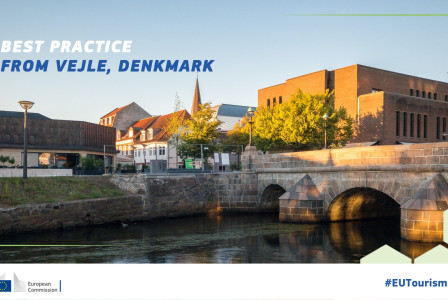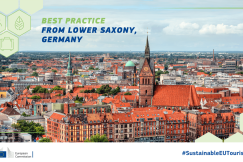Best practices
23 September 2025
Sustainable EU Tourism project - best practice: Vejle
Best practices
23 September 2025
Ecotourism
Gastronomy tourism
MICE tourism
+7 more
Login / create an account to be able to react
-
20

Vejle, Denmark, has positioned itself as a model for sustainable tourism by supporting small businesses in their green transition. Through a handbook, workshops, one-to-one consulting, and stakeholder networks, the city fosters collaboration and equips tourism companies with tools to adopt sustainable practices and meet evolving visitor expectations
Sustainable EU Tourism project
Topics
Denmark
Destination Management & Marketing Organisations
Local Authorities
-
Specific types of tourism
-
-
Ecotourism
-
Gastronomy tourism
-
MICE tourism
-
Urban/city tourism
-
-
Transition Pathway Strategic Areas
-
-
Best practices, peer learning and networking
-
Governance of tourism destinations
-
Green Transition of Tourism Companies and SMEs
-
R&I on climate-friendly tourism
-
-
Business activities
-
-
Hotel and similar accommodation
-
Other
-
Share
Vejle, Denmark, has been recognised as a best practice by the Sustainable EU Tourism project for its comprehensive approach to supporting small tourism businesses in sustainability.
Amid the growth of tourism and global biodiversity challenges, Visit Vejle launched a three-year sustainability project, backed by municipal funding, to guide stakeholders towards greener practices.
Key initiatives include the Handbook to a Green Destination, offering practical guidance and checklists; more than ten workshops on topics ranging from waste and energy management to social sustainability and communication; and free one-to-one consulting sessions that provide companies with tailored assessments and improvement plans.
The VisitVejle network, established in 2010, brings together more than 150 stakeholders, enabling knowledge sharing and collaboration, while the Green Guide highlights local sustainable businesses and inspires tourists to make greener choices.
This strategy has led to concrete results: increased interest in sustainability among companies previously hesitant due to perceived costs, strong satisfaction with workshops, and certifications such as Green Attraction and Hidden Disabilities being adopted by local businesses.
Vejle’s experience shows how local leadership, stakeholder collaboration, and practical tools can drive meaningful progress in sustainable tourism and empower even small enterprises to become part of the green transition.
For more details on the key challenges the destination has faced, and the solutions implemented to address them, please refer to the attached document.
Documents
Comments (0)
See also
Sustainable EU Tourism - Key challenges and best practices
- Categories
- Coastal, maritime and inland water tourism Cultural tourism Ecotourism +64 more
92 cities awarded EU Mission Label for climate neutrality
- Categories
- Urban/city tourism Governance of tourism destinations Green Transition of Tourism Companies and SMEs +29 more
Sustainable EU Tourism project - best practice: Lower Saxony
- Categories
- Cultural tourism Ecotourism MICE tourism +30 more



